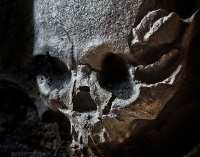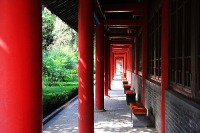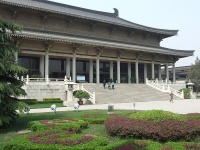
On the outskirts of Xi'an city, on the bank of the Chanhe River, are the remains of the ancient settlement of Banpo, dating from about 5000 BC. The remains were discovered in 1953 by workers laying the foundations for a factory. Upon further investigation, the site proved to make up one of the most complete example of an agricultural Neolithic settlement in the world. The site contains the ruins of more than 40 homes, 200 cellars, numerous storage pots, a collection of pottery and tools, a pottery-making centre, and more than 250 graves belonging to a matriarchal community of the Yangshao culture. There is an on-site museum constructed over the excavation site with two smaller exhibition halls displaying the archaeological artefacts that have been unearthed. More than 400 archaeological sites similar to Banpo have been discovered in and around the Yellow River Valley in China, giving the area the reputation of being the birthplace of ancient Chinese culture. Banpo is an essential visit for those interested in archaeology and ancient history.
Website : www.banpomuseum.com.cn

Though there are many collections of steles (stone tablets) in China, only Xi'an's is large enough to warrant being called a forest. There are more than 3,000 ancient steles in this library, dating back to the Tang Dynasty (618-907). The Beilin Museum itself is nearly as old, having been established in 1087. The steles are divided into seven exhibition halls, and display classic examples of traditional Chinese calligraphy, painting, and historical records. It is a scholarly museum, and perhaps not as thrilling as some other sites, but travellers interested in history, writing, calligraphy, poetry, or philosophy will be enthralled by the ancient collection. It is recommended that visitors hire one of the library's excellent English guides, as without some assistance, a lot of the interesting history and the cultural relevance of the inscriptions will be inaccessible. Apart from its impressive collection, the museum building has lovely grounds with fountains and pagodas, making it a great place to relax after a long day of sightseeing. It is also one of the less crowded tourist attractions. Ink rubbings of some of the most famous tablets are for sale in the gift shop.
Address : 15 Sanxue St, ZhongLou ShangQuan, Beilin Qu
Website : www.beilin-museum.com
Telephone : 029 8721 0764
The Great Mosque is the pride of China's Islamic community and is a popular tourist attraction. The mosque is near the Drum Tower in the Islamic residential area. Islam came to China along with Arab merchants and travellers in roughly the year 600. The Great Mosque in Xi'an is the best-preserved ancient mosque in China, having been built in 742, during the Tang Dynasty. It is built in traditional Chinese style with platforms, pavilions and halls, and is rectangular in shape, divided inside into four courtyards. Visitors can explore the passages, courtyards and archways and admire the furniture and fittings, most of which date from the Ming and Qing Dynasties. The main prayer hall can accommodate 1,000 and its ceiling bears more than 600 classical scriptures in colourful relief. The Great Mosque is a rewarding travellers destination, particularly because the mix of Islamic and Chinese architecture and design is interesting and unique. It is surrounded by landscaped gardens which make for a quiet sanctuary and are worth strolling around. It is a place of worship though, so visitors should dress appropriately and behave respectfully.
Address : 30 Huajue Alley, Xincheng District
Opening times : Daily 8am-7pm
Admission : March - November CNY 25, December - February CNY 15

The Huaqing Hot Springs, located about 22 miles (35km) east of Xi'an city, at the base of the Lishan Mountains, is where the ancient emperors bathed and relaxed in scenic surroundings. Huaqing is one of the Hundred Famous Gardens of China and the setting of the baths is very beautiful. The spa has been operating since the days of the Tang Dynasty, and its warm (109°F/43°C) mineral waters, containing lime, sodium carbonate, and sodium sulphate, are still enjoyed by locals and visitors today.The waters are particularly recommended for the treatment of dermatitis, rheumatism, arthritis and muscular pain. The ancient imperial bathing pools can be visited, including the Hibiscus pool, dating from the year 712, which has been restored and is open to the public. There is also a fascinating museum at the site containing building materials from the Tang Dynasty.Another attraction at the springs is the Hovering Rainbow Bridge, which reflects the sunset in such a way that it appears to be a rainbow. Visitors can take a cable car up the mountain to experience the aerial view. Huaqing is the setting for a famous Chinese love story about the Emperor and his lover and this romance is the central theme of the attraction. Visitors will only need a few hours here, but it makes for a good side excursion on their way to the Terracotta Warriors.
Address : No. 3 Huaqing Road, Linyi
Website : www.hqc .cn
Telephone : 029 8381 2003

In 1974, a group of peasants digging a well north of Mount Lishan in Lintong county, about 18 miles (30km) from Xi'an, unearthed fragments of a life-sized warrior figure. Because the site of the discovery was just one mile (2km) from the as yet unexcavated tomb of Chinese emperor Qin Shi Huangdi, who ruled between 246 and 210 BC, archaeologists grew excited. Further excavation revealed several timber-lined vaults filled with thousands of greatly detailed terracotta soldiers and their horses and chariots: an entire army assembled in position to follow Emperor Qin into eternity. The pits containing the army are now open to public viewing and thousands of visitors flock to gaze at the stunning array of figures with their vivid facial expressions.The Terracotta Army Museum consists of the original pit that was discovered in 1974, which has been enclosed within a hangar-like building to preserve the ranks of 6,000 soldiers found there. A second pit, containing 1,400 figures of cavalrymen, horses and infantrymen, and 90 wooden chariots, is also part of the museum. Visitors can also see Qin's Mausoleum and view almost 100 sacrificial pits containing the skeletons of horses, complete with hay, that were buried with him. There are also about 20 tombs holding the remains of his counsellors and retainers. The emperor's tomb itself is under a 249-foot (76m) high mound that has not yet been excavated, but is believed, according to historical records, to have contained rare gems and other treasures.
Website : www.bmy.com.cn

The graceful complex of buildings that constitute the Shaanxi Provincial History Museum in Xi'an's southern suburbs is built in the style of a Tang Dynasty pavilion, and is itself a sight worth seeing. The museum's exhibits, however, are even more breathtaking, consisting of about 113,000 artefacts unearthed in the province and chronologically arranged in three exhibition halls. The exhibits cover the Han, Wei, Jin, North and South, Sui, Tang, Song, Yuan, Ming, and Quing dynasties, as well as the prehistoric and bronze period. Shaanxi province was a vital region for the cultural development of China; it was the capital of 13 glorious dynasties. The Shaanxi Provincial History Museum stands as testament to the area's importance: it is a treasure trove of Chinese civilization. The museum is China's premier history museum and everything is world-class. The lines at the entrance can be extremely long, so travellers are advised to get there early to avoid the crowds and to get a free ticket (4,000 free tickets are available every day, visitors must just present their passport to get one).
Address : 91 Xiaozai road
Website : www.sxhm.com

Travel Guide powered by Word Travels, copyright © 2023 Globe Media Ltd. By its very nature information in this travel guide is subject to change at short notice and travellers are urged to verify information on which they're relying with the relevant authorities. Neither Globe Media Ltd nor Travel Vogue can accept any responsibility for any loss or inconvenience to any person as a result of information contained above.